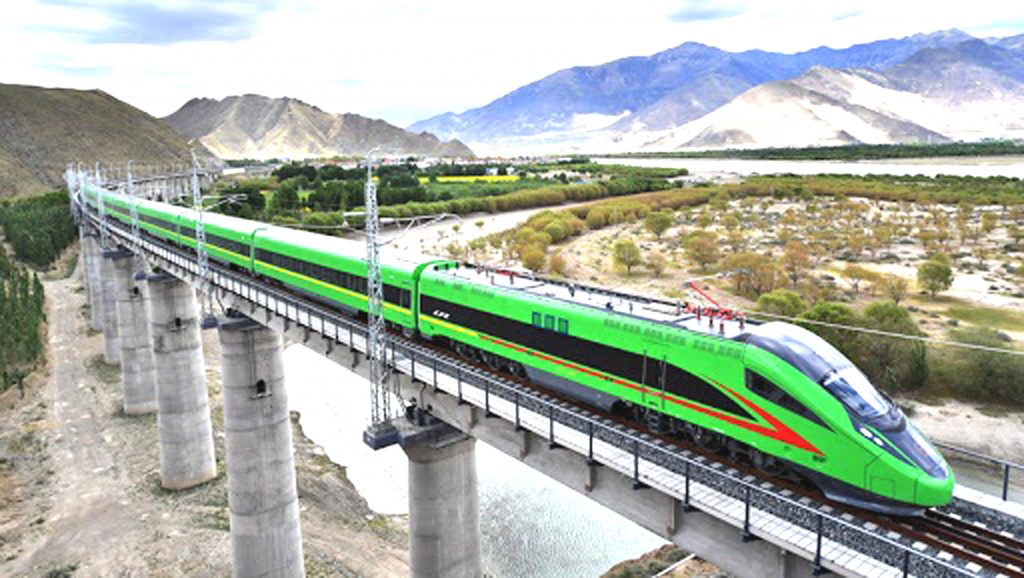China launches first bullet train of 435.5 km long railway near Indian border in Tibet
From Bhupen Goswami

GUWAHATI : China is continuously developing infrastructure in the border areas amid tensions with India. In the same vein, it has started operating a fully electric bullet train in the remote Himalayan region of Tibet, the first such train here. China operates the train on Friday connecting Tibet’s provincial capital Lhasa to Nyingchi, a Tibetan border town strategically close to Arunachal Pradesh.
India is closely monitoring the entire development. In the Brahmaputra river, this railway line passes through 47 tunnels, 121 bridges and crosses the Brahmaputra river 16 times. About 75 per cent of the railway line is tunnels and flowers. The Brahmaputra river goes to the region, and plains, a wonderful view of the Siang river emanating from the hills of Arunachal, known as the Brahmaputra. China has taken a major step towards gaining a strategic edge over India by running the first bullet train in the Himalayan Tibet region, which is considered strategically important.China has launched a bullet train between Tibet’s capital Lhasa and Shah Nyingchi bordering Arunachal Pradesh.
According to Chinese government Media Global Times, the project has been developed under the Sichuan-Tibet Railway and the bullet train has been launched ahead of the 100th anniversary of the Communist Party of China on July 1. The bullet train will cover a distance of 435.5 km between Lhasa to Nyingchi stations. According to the report, the first electric train in the Tibet Autonomous Region opened on Friday morning and will connect Lhasa to Nyingchi and is a bullet train that has officially started operating. China’s National Railway Corporation (CNRG) said that the commencement of bullet train operations and opening up of traffic is very important for strengthening connectivity and exchanges between Tibet and other provinces and regions of China and this is an important step to maintain ethnic unity, strengthen stability in border areas as well as promote development of rural areas.The bullet train, launched by China in Tibet, will pass southeast of the Qinghai-Tibbat plateau, which has the status of being one of the most geologically active regions in the world. Sichuan-Tibet railway is tibet’s second railway project after Qinghai-Tibet.
Just last year, Chinese President Xi Jinping ordered officials to start work on a railway project connecting Sichuan province and Tibet’s Nyingchi at a rapid pace. The Chinese President described the rail project as an important step to bring stability to China’s border region. According to the report, the Sichuan-Tibet rail route will start from Chengdu, the capital of Sichuan province, and enter Tibet and pass through Tibet to Chamdo. With the introduction of this bullet train, the distance from Chenkdu to Lhasa, which was earlier covered in 48 hours, will now be completed in just 13 hours. Let me tell you that Nyingchi is a city in Medog province, which borders the State of Arunachal Pradesh, India.Earlier, China had described Arunachal Pradesh, an integral part of India, as part of South Tibet, which was rejected outright by India. Let me tell you that the Indo-China border dispute involves a 3,488 km long line of actual control, which we commonly call LAC. Kian Ton, director of the research department at the National Strategy Institute at Xinhua University in China, told the Global Times that “if a dispute-like situation arises or a crisis occurs along the Indo-China border, it will go a long way in delivering strategic material to China through this Railway. In such a situation, tibet has strategically increased the challenge for India along the border with Arunachal Pradesh. “If the dispute on the Indo-China border persists, this Railways will provide china with a great facility to carry strategic materials to these areas,” said Kian Feng, Director, Department of Research at the National Institute of Strategy at Singhua University.


